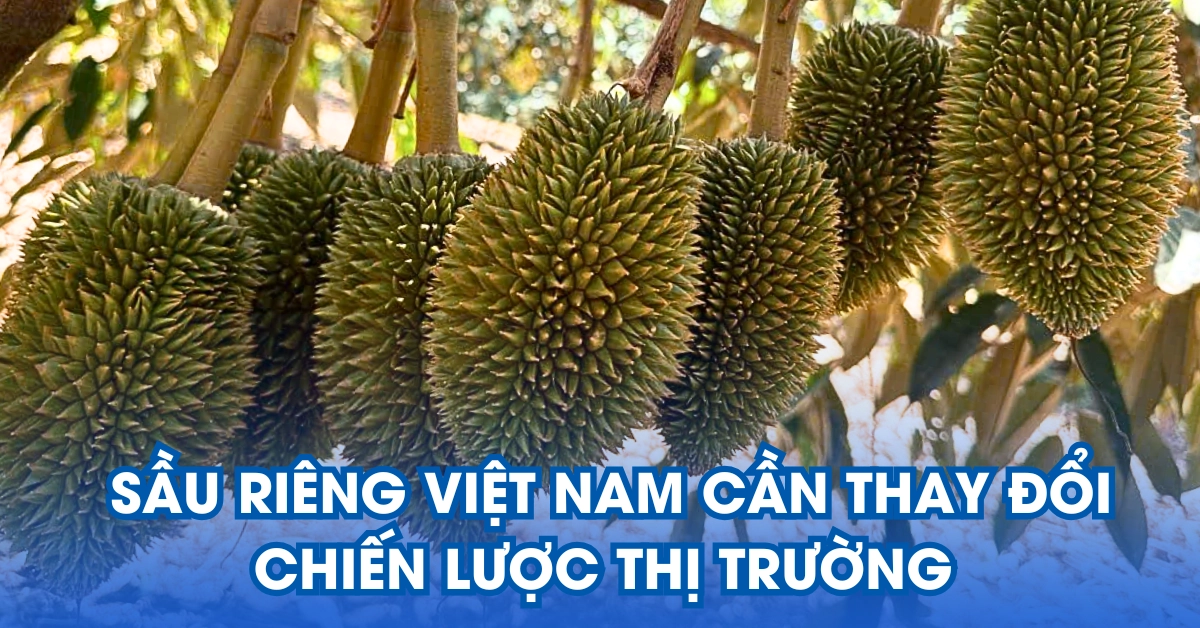Vietnamese Durian It's Time To Change The Market
13 Jun 2025

In the first quarter of 2025, Vietnam's durian exports dropped by over 60%, with prices plunging due to heavy reliance on China – Vietnamese agriculture needs a new strategy to break free from this passive position.
The Chinese market opens: Necessary but not sufficient conditions
On May 22, 2025, the Department of Crop Production and Plant Protection announced the latest information on the issuance of codes for growing areas and packaging facilities for durian exported officially to China. Accordingly, the General Administration of Customs of China (GACC) approved an additional 829 growing area codes and 131 packaging facility codes - bringing the total to 1,396 areas and 188 facilities nationwide.
This is an important step forward to help Vietnamese durian expand its official export scale. However, according to Director Huynh Tan Dat, being granted a new code is only an input condition - that is, a necessary condition. For sustainable development, the Vietnamese durian industry needs to continue investing in product quality, cultivation techniques and improving market strategies.
Durian exports plummet: Warning from weak domestic strength
Severe decline in volume and value
According to data from the General Department of Customs, the total durian export volume in the first quarter of 2025 reached only 26,860 tons, worth 98.2 million USD. Compared to the same period in 2024, output decreased by 52.7% and value decreased by 61.1%. This is an alarmingly deep decrease, reflecting the great difficulties the industry is facing, despite having the advantage of a growing area of up to 180,000 hectares, with an estimated output of 1.55 million tons.
Over-reliance on the Chinese market
China currently accounts for more than 90% of Vietnam's durian export output. When the country tightened quality control, applied stricter standards and stricter quarantine procedures, thousands of tons of Vietnamese durian immediately encountered difficulties in output. Excessive dependence has left the durian industry in a passive state.
Need a proactive and sustainable market strategy
Diversify export markets
To reduce risks and expand opportunities, the Vietnamese durian industry needs to gradually approach other potential markets such as Japan, Korea, the Middle East, the EU and the US. Although requiring higher quality, these are markets with good purchasing power and few policy fluctuations. Conquering these markets requires serious investment in farming standards, traceability and post-harvest processes.
Spreading crops: From techniques to market strategies
Instead of massive seasonal harvests, spreading crops appropriately helps reduce pressure on the market, avoiding the situation of "flooding the market" causing prices to fall dramatically. This is not only an agricultural technique but also a strategic solution to regulate supply and demand, learning from the experience of Thailand - the leading country in durian export.
Strengthening chain linkages and quality monitoring
Cooperatives and enterprises play a key role
The link between farmers - cooperatives - enterprises - management agencies needs to be further tightened. Cooperatives need to organize technical training, guide production according to standards and sign contracts with exporting enterprises. Key enterprises need to properly implement the preliminary processing, packaging and quarantine processes registered with Chinese partners.
Workers packing durian in a modern factory. Photo: internet
Tighten monitoring of growing area codes
Faced with concerns about some growing areas violating quality regulations, the Dak Lak Durian Association has sent a petition to the Ministry of Agriculture and Environment requesting a review of the growing area code granting process and strict handling of violations. This is a necessary move to protect the reputation of the entire industry, avoiding the situation of "one bad apple spoiling the barrel".
Building the Vietnamese durian brand in the international arena
Need to tell the different story of Vietnamese durian
Currently, Vietnamese durian still does not have a clear brand in the international market. Building a national brand needs to be accompanied by a systematic communication strategy: from packaging, labels, QR codes to trace the origin to digital communication campaigns through e-commerce platforms, KOLs and international fairs.
Increasing value instead of chasing quantity
To have a higher position, the Vietnamese durian industry needs to change from the mindset of "selling fruit" to "selling value and story". This helps the product gain the trust of consumers, who are willing to pay high prices and become more competitive compared to Thai or Malaysian durian.
Vietnamese farmers apply the technique of growing durian in different seasons. Photo: internet
Conclusion
China's expansion of growing area codes is just the beginning. To develop sustainably and escape the situation of "good harvest, low price", the Vietnamese durian industry needs to transform comprehensively:
- Improve internal product quality
- Diversify export markets
- Tightly link the chain and professionalize production
- Build the Vietnamese durian brand in the international market
The opportunity is coming, but if the strategy is not changed today, the Vietnamese durian industry may lose the opportunity to reach out to the world.
Views
518
